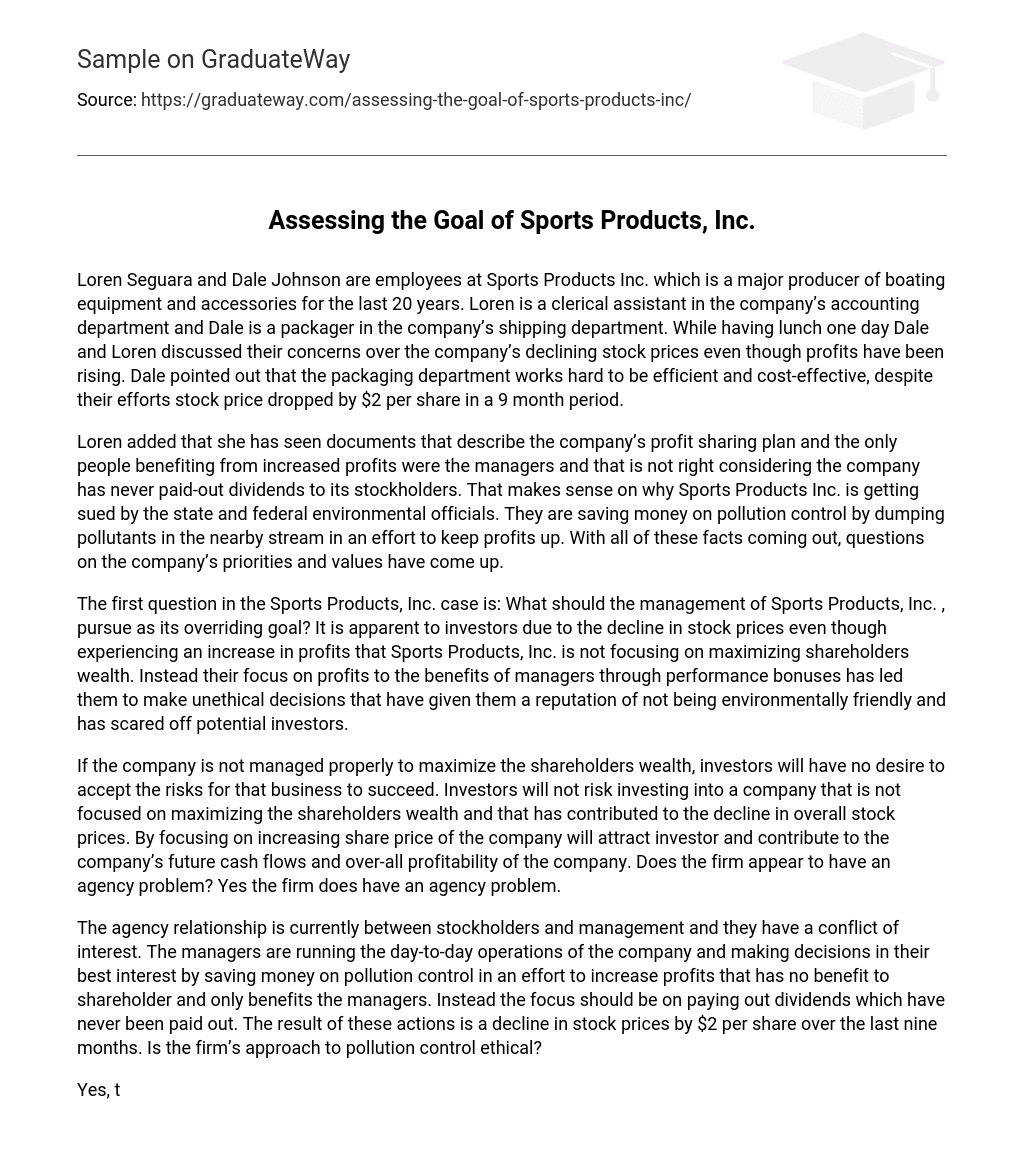Loren Seguara and Dale Johnson are both employees at Sports Products Inc., a leading provider of boating equipment and accessories for the past two decades. Loren serves as a clerical assistant in the accounting department, while Dale works as a packager in the shipping department. During a lunch break, they shared their worries regarding the company’s declining stock prices, despite its increasing profits. Dale noted that the packaging department tirelessly strives to improve efficiency and reduce costs. Nevertheless, the stock price plummeted by $2 per share over a nine-month period.
Loren mentioned that she has observed records detailing the profit sharing scheme of the company, whereby only the managers are benefiting from increased profits. This is concerning because the company has never distributed dividends to its stockholders. It is understandable why Sports Products Inc. is facing legal action from state and federal environmental officials as they are cutting costs on pollution control by disposing of pollutants in a nearby stream to maintain profits. The revelation of these facts has raised doubts about the company’s priorities and values.
The central issue in the Sports Products, Inc. case is determining the primary objective of management. Even though profits have increased, the decrease in stock prices reveals that Sports Products, Inc. is not focusing on maximizing shareholders’ wealth. Rather, their emphasis on generating profits for managerial perks like performance bonuses has led to unethical decisions that harm their reputation as an environmentally irresponsible company and discourage potential investors.
If the company is not effectively managed to maximize shareholder wealth, investors will be hesitant to take on the associated risks. They will be unwilling to invest in a company that does not prioritize shareholder wealth maximization, leading to a decrease in stock prices. Focusing on increasing the company’s share price will attract investors and improve future cash flows and overall profitability. Is there an agency problem within the firm? Yes, indeed there is.
The current agency relationship between stockholders and management is marked by a conflict of interest, as managers prioritize their own interests over those of shareholders. They do this by cutting costs on pollution control measures to increase profits, ignoring any potential benefits for the shareholders. Rather than focusing on distributing dividends, which have never been given out, attention should be placed on determining if the firm’s approach to pollution control adheres to ethical standards. These actions have resulted in a decrease of $2 per share in stock prices over the past nine months.
Indeed, the company is consciously choosing profit over both stock prices and the environment. Assuming that they were unaware of polluting the local water source, it becomes necessary to discuss their actions. After being sued by state and federal environmental officials, it was expected for them to take responsibility by publicly stating their commitment to cleaning up the pollution and implementing preventive measures.
Their actions demonstrate a prioritization of their own interests above the shareholders, environment, and local residents, which is morally unacceptable. If they were to take the initiative in shouldering the expenses for pollution control measures, not only would it foster goodwill towards the company as a responsible corporate entity but also result in positive long-term outcomes, despite potentially negative impacts on profits initially. Does the firm showcase an effective corporate governance system? It appears not.
According to BusinessDictionary.com, the corporate governance framework includes explicit and implicit contracts between the company and stakeholders for distributing responsibilities, rights, and rewards. It also involves procedures for reconciling conflicting interests of stakeholders based on their duties, privileges, and roles. Additionally, it encompasses procedures for proper supervision, control, and information flows to function as a system of checks-and-balances (Corporate Governance, 2012).
The text states that there are no clear contracts between management and stakeholders regarding responsibilities, rights, or profit distribution. Additionally, there is a lack of checks and balances and procedures for resolving conflicts.
To summarize, I suggest the company establish a corporate governance structure that defines roles, shareholder rights, conflict resolution protocols, and initiate dividend distributions. Furthermore, I propose the company prioritize its responsibilities as a socially responsible corporate entity by ensuring accountability to the environment and local community it operates in.
References
The information provided in this text is sourced from “Corporate Governance” on BusinessDictionary.com, which was accessed in November 2012. The webpage can be found at http://www.businessdictionary.com/definition/corporate-governance.html.





